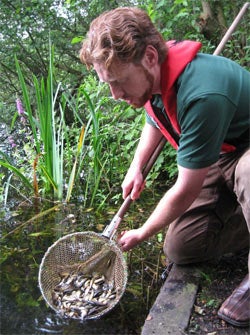More than 400,000 fish were stocked in rivers, canals, ponds and lakes across England and Wales last year as part of the Environment Agency’s on-going work to maintain, improve and develop freshwater fisheries. The fish were raised at the Environment Agency fish farms at Calverton and Leyland where the highest levels of biosecurity are maintained to prevent the introduction of disease. A significant proportion of the money needed to finance fish stocking comes from the rod licence. There are three main reasons for us to be involved in a fish introduction. They are:- Mitigation: Offsetting the effects of a scheme that causes a loss of natural production. Restoration: Stocking done after things that limit natural production have been removed. This can include kick starting populations that could benefit from habitat improvements. Enhancement: Stocking to supplement existing stocks, where other factors limit natural production. We will also stock fish to develop new fisheries (particularly stillwaters for urban regeneration projects). The Environment Agency only stock species that are native to rivers, for example, we would not stock barbel to a river that has not had or does not have barbel. The number of fish is governed by the size of the river and the habitat available. Nearly 130,000 dace were stocked. In Anglian region the River Welland received 19,000, the River Slea received 5,000 and the Ivel, Great Ouse and Witham received 1,750. More than 46,000 dace were stocked across the North West region, including the Wyre, Lune, Dane, Team and Calder. The Midlands region received more than 38,000 which were stocked in the Leam, Derwent, Arrow, Soar, Tame, Churnet, Wreake, Trent, Idle, Maun, Meden and Dove. Nearly 9,000 were stocked in the Thames region in the Cherwell, Roding, Ray, Ver, Colne and Wandle. Another 7,500 were stocked in the North East region mainly in the Don, Nidd, Dearne and Aire. More than 11,000 grayling were stocked mainly in the North East and Midlands region, including 3,000 in the River Aire, 1,500 in the River Derwent, 1,500 in the River Dove and 1,500 in the River Manifold. Another 2,000 were stocked across the Midlands in the Morda Brook, Gayton Brook and River Sence. In addition, 1,000 grayling were stocked in the River Chess and River Colne in the Thames region. The River Lark in Anglian and River Frome in the South West received several hundred grayling. Almost 21,000 chubb were stocked, including 8,700 across the Thames region in the Roding, Cherwell, Ray, Ver, Colne, Wandle, Hogsmill and Ravensbourne. Nearly 4,000 were stocked across the North Eastern, including the Nidd and Tyne, 2,500 were stocked in Welland, Ivel and Great Ouse in the Anglian region, the Dorset Stour in the South West received 2,000 and the Midlands received 3,500 which were shared between the Derwent, Tame, Churnet and Dove. More than 53,000 bream were stocked in rivers, canals and stillwaters across in most regions. The North East received 27,000 bream which were stocked in the Wharfe, Derwent, Ure, plus numerous fisheries, ponds and park lakes. Anglian region received more than 3,000, which were destined mainly for the River Slea, while Thames region stocked some 2,500 fish in Lee, Cherwell and Ray. The Dorset Stour in the South West received 2,000 bream. Midlands region received 7,500 which were stocked in the Derwent, Amber, Avon and Soar. Another 7,000 bream were stocked in ponds and tarns across the North West region, and 4,000 were stocked in rivers, ponds and lakes in Wales, including the River Dee. Almost 68,000 crucian carp were also stocked in stillwaters such as fisheries, ponds, lakes, quarries, tarns, moats and pits across all regions, except the South West. The North West region received nearly 11,000, Southern 5,750, Anglian 8,900, Midlands 9,500, Thames 3,100, North East 22,500 and Wales 7,000. Just over 6,000 tench were also stocked in stillwaters and canals. Some 103,000 roach were delivered to all regions, except the South. The Wharfe, Derwent, Ure and Aire in the North East shared 14,000 fish between them, the Midlands released 24,000 fish into the Alfreton Brook, Derwent, Amber, Avon, Soar, Tame, Wreake, Trent, Idle, Maun and Meden. More than 8,500 bream were stocked by Thames region into the Roding, Lee, Cherwell, Ray and Wandle. Another 13,000 fish were released across Anglian region into rivers such as the Ivel, Great Ouse and Slea. Welsh ponds and lakes received 3,000 bream. More than 27,000 were stocked in the River Dane and River Wyre, and a dozen or so lakes and ponds, in the North West. Nearly 7,000 barbel were stocked, mainly in the North East and Thames regions, including 2,500 in the River Don and 1,000 in the River Aire, and 2,750 shared between the River Thames, Lee, Wey and Wandle. Just over 4,000 rudd were also stocked in lakes and ponds in the Midlands, North East, Southern and Thames regions, plus 2,000 in the River Slea in Anglian region. |
Welcome!Log into your account











